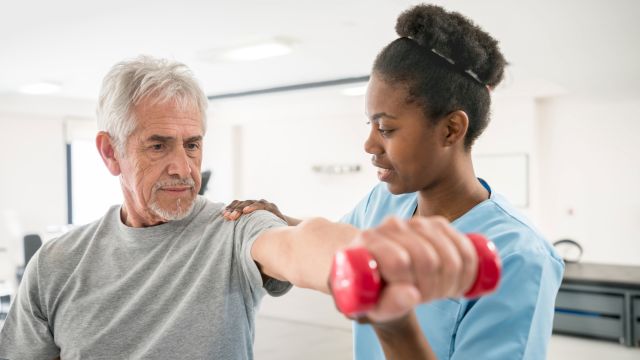Updated on October 31, 2024.
Of the joint replacement surgeries, shoulder replacement is performed much less often than knee or hip replacements. More than 100,000 people in the United States have shoulder replacement surgery each year, according to a May 2021 study in the Journal of Shoulder and Elbow Surgery. That’s compared to almost 800,000 knee replacements and about 544,000 hip replacements.
“Replacement” seems to imply that your entire shoulder will be removed and new parts put in. In reality, it involves replacing two parts with artificial components, called prostheses. Whether one or both parts of the joint will be replaced depends on the amount of damage they show.
Why you might need a shoulder replacement
If you think about normal motion at the shoulder, you’ll realize that this joint allows the arm to move in an arc in any direction. The reason is that the joint consists of a ball at the top of the arm bone that fits into a cup-like structure, or socket, on the outer side of the shoulder blade.
In a healthy shoulder, the ball moves easily in the shallow socket, allowing for circular arm motion. Both bony structures also have a protective covering of cartilage and a nearby fluid-producing membrane to keep the joint lubricated.
With age, overuse, some inflammatory diseases or injury, the protective cartilage can wear away. The result is bone-on-bone contact every time you move your arm. The damage can lead to pain and inflammation and the need to replace these parts. In a shoulder replacement surgery, the ball can be replaced with a metal version, a plastic socket can replace the worn-out original or both structures can be replaced.
If you’ve tried all the nonsurgical routes to relieving shoulder pain and stiffness and are still hurting, your clinician may talk to you about shoulder replacement. The good news is that patients can “typically expect about 90 percent improvement in symptoms after surgery” once they allow for appropriate healing time and therapy, says Kareem Sobky, MD, an orthopedic surgeon in Denver.
If shoulder replacement is right for you, here are a few things to know about what happens before, during, and after the surgery.
Before the procedure
Leading up to your surgery, you may undergo some imaging studies, such as X-rays, so your healthcare provider can confirm the extent of joint damage. You and your clinician will also want to be sure that you’ve exhausted the nonsurgical possibilities, says Sobky. “It is important for patients to use non-surgical treatments such as steroid injections and physical therapy before moving ahead with surgery,” he says.
Also important, says Sobky, is to be in the best physical and medical condition you can before surgery. You won’t be able to use your arm for several weeks after you come home, so making preparations on the home front is also a good idea. These steps include moving items you need from high shelves to lower locations and making sure that you have help for daily activities, such as cooking, bathing, and laundry.
During the actual procedure
The type of shoulder replacement that mimics the existing shoulder anatomy—with the socket at the shoulder and the ball at the top of the arm bone—is called “anatomic” or conventional shoulder replacement. Sobky says that patients under 70 years of age who have intact tendons and muscles to support joint function are typically good candidates for this kind of surgery.
Patients over 65 or whose tendons and muscles are in poor condition are more likely to be considered for a “reverse” shoulder replacement, says Sobky. In that procedure, the new socket is placed at the top of the arm bone rather than at the shoulder bone, and the ball is fixed at the shoulder socket. The result is that instead of a socket–ball order of structures, the shoulder joint will be reversed to ball–socket. This reversed joint stabilizes more easily and doesn’t require as much work from the damaged muscles and tendons, while recruiting other muscles to help lift the arm.
For either approach, patients will have general anesthesia and a nerve block that will numb pain for up to several days, Sobky says. Unlike joint surgeries for more minor repairs, which can use tiny holes and little cameras to achieve results, a replacement surgery requires an incision to open up the shoulder. Worn out joint bone will be replaced with the prostheses. The procedure typically takes a couple of hours.
Risks and complications
The main near-term risks with this kind of surgery are infection or injury to surrounding tissues, such as arteries or nerves. After your surgery, if you have bleeding that soaks your dressing, pain that medication does not manage, swelling or darkening of the skin on your arm or fingers, fever, chest pain, or a feeling that your joint feels loose, contact your healthcare provider.
Over the long term, says Sobky, risks include an unstable implant, persistence of pain, or incomplete return of joint function. If muscles around the joint were damaged before surgery, another risk is that they might not heal completely even after surgery, he says.
Complications with this surgery are quite rare, with a rate of less than 5 percent. Over the course of 10 years, about 3 percent of the replacement joints are loose, but even in those cases, further surgery is rare.
Recovery and rehab
Sobky says that most patients will require an overnight in the hospital, but he also will do the surgery on an outpatient basis for certain good candidates. After leaving the hospital, the patient needs to be patient about healing. They can expect to use a sling for the first six weeks, with “very gentle physical therapy,” Sobky says, and no lifting, pushing, carrying, or pulling things. That said, you might be surprised to learn that many patients actually begin their physical therapy on day one after the surgery.
After that period of resting the shoulder and recovery, a “more aggressive” physical therapy routine comes next, says Sobky. That doesn’t mean it’s time to break out the kettlebell—this stage still involves limitations on what you can lift or carry. The final six weeks will focus on gaining strength.
By the time it’s all over, “most people are doing very well and returning to activities like golf or tennis around four months after surgery,” Sobky says. Full healing can take a year, but it’s incremental. “I typically see improvement in motion, function, and pain over the course of a year after surgery,” he adds.







